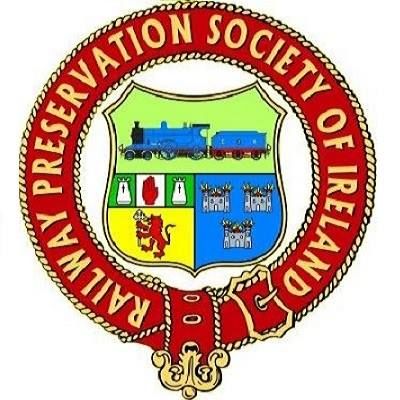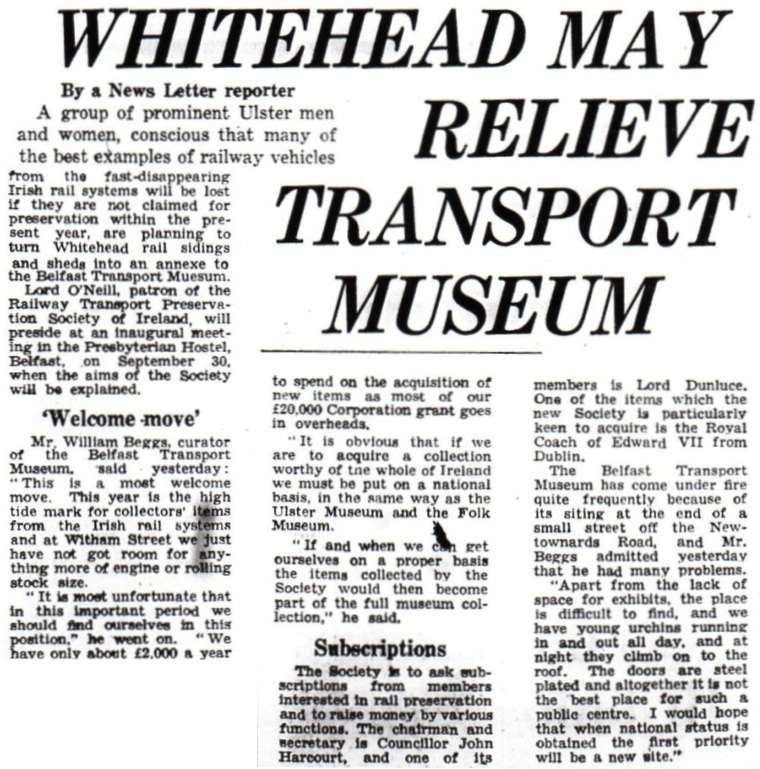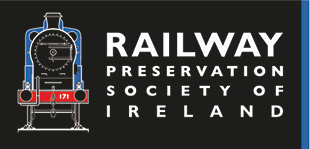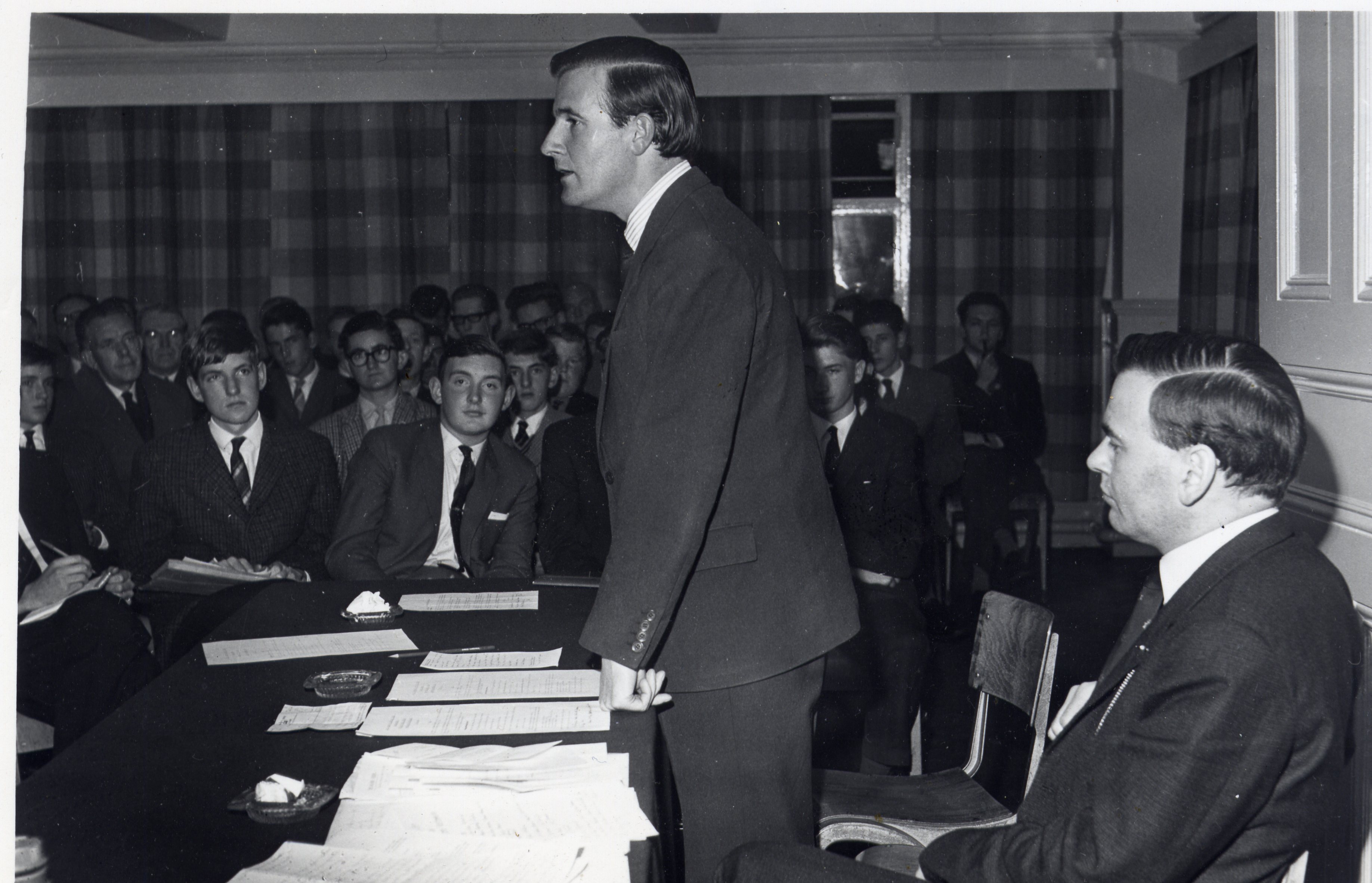History of the Railway Preservation Society of Ireland

In the early 1960s the future of the railways did not seem to be particularly threatened. The swingeing closures of 1956/7 on the former GNR seemed to have consolidated the network, and it appeared that steam traction would only gradually disappear. The Benson Report was commissioned in Northern Ireland in 1963, a little after the McKinsey Report in the Republic. The major part of both these reports was implemented resulting in a further set of closures - in the south the West Cork lines, the bulk of the DSER inland routes and many minor branches fell to the axe, while in the north the GNR "Derry Road" finally succumbed.
However, it looked as though the railways would escape any further closures, and the investments in new locomotives, railcars and coaches seemed to suggest that the future for the surviving lines was secure. It was in such a climate that the following events unfolded.
Shortly after a railtour to Portrush, organised by the Inst (Royal Belfast Academical Institution) Railway Society in September 1963, an ad hoc organisation was set up to run steam railtours in the last days of steam. This was known as the "Northern Ireland Railway Societies Joint Committee", and was empowered by the committees of the Irish Railway Record Society (Belfast Area), the Royal Belfast Academical Institution (Inst) Railway Society, the Northern Ireland Road and Rail Development Association, and the Friends of the Belfast Transport Museum to organise and run railtours on their behalf, as none of these societies felt that they had enough financial resources or a large enough membership base to do so on their own.
Derek Young (NIRRDA), Michael Shannon (FBTM), Denis Grimshaw (as secretary), Sullivan Boomer (RBAIRS), John McGuigan (IRRS) and Craig Robb were the members of the NIRSJC.
Incidentally, the NIRSJC had absolutely no constitution, official or legal status whatsoever - but people didn't worry about things like that in those days!
A successful railtour was operated from Belfast to Loughrea and back on 4th April 1964, with VS No.207 from Belfast to Dublin and back, although the Dublin-Loughrea section was operated by a diesel railcar set instead of steam traction as originally intended - not because CIÉ would not agree to steam, but purely on grounds of cost.
The major factor which had killed off the idea of using one or two of CIÉ's remaining J15s (or GNR(I) Qs No.131 or No.132, at least one of which was considered to be repairable) from Dublin to Loughrea and back was CIÉ's estimated locomotive repair costs.
The only market for railtours in the 1960s was considered to be the railway enthusiast market - no Portrush Flyers, Santa Trains or other general public ventures were considered viable - really because the general public still thought of steam trains as normal everyday transport.
The virtual end of steam operations on CIÉ, and the apparently rapidly approaching demise of steam on the UTA (before the Magheramorne Spoil Contract deferred the evil day!), together with the experience of the Loughrea tour were instrumental in turning the thoughts of three of the Joint Committee's members to establishing a preservation society which would own the locomotives, keep them in traffic, and could overhaul and maintain them largely with volunteer labour.
The examples of the Bluebell and Keighley & Worth Valley Railways in Britain were noted, but widespread main line operations were always considered vital, rather than an attempt to purchase and operate a branch line or other section of closed railway.
The other fundamental decision, based on market potential for railtour passengers, availability of representative locomotives and rolling-stock from all former Irish railways and a larger variety of routes for special trains, together with the potential for a larger membership base, and not from any political considerations, was to establish the new society on an all-Ireland basis. Even the very limited experience of the Loughrea tour had indicated that better access to the potential railtour market in the Dublin area could have helped the venture.
So it was that following the Loughrea railtour in April 1964 Derek Young, Michael Shannon and Denis Grimshaw met in York Road waiting room (quite a spacious and comfortable place in those days) on several occasions. And it was there, in the early summer of 1964, that the decision to set up the RPSI (and the choice of name) was made.
The remaining NIRSJC members (Sullivan Boomer and John McGuigan) and a number of other prominent members of the various railway societies were then roped in, to help to establish the new organisation, and gain acceptance and credibility from the railways (UTA and CIÉ) and other external bodies. It is always dangerous to name individuals, as someone will feel left out, but Laurence Liddle, John Harcourt, Lord O'Neill, Craig Robb, Harry Frazer and Drew Donaldson, were all involved.
An inaugural meeting of the "Railway Preservation Society of Ireland" was held in Belfast on 30th September 1964 - and the rest, as they say, is history. On that occasion, Denis Grimshaw was elected as Secretary - the first of two spells in the post.
 |
| Announcement of the inaugural meeting. (Belfast Newsletter 22/9/1964) |
Of the original three, Derek Young passed away in 2021 and Denis Grimshaw has stepped down as an active RPSI member - Michael Shannon left Belfast to live in England shortly after the RPSI was formed. Of the original committee, Sullivan Boomer sadly passed away in 2015, John Harcourt is a regular supporter, the late Laurence Liddle maintained contact in Five Foot Three into his nineties from Australia, and Craig Robb still took an occasional photograph before his untimely death.
Having acquired our first locomotive in 1965, the RPSI moved into our Whitehead, Co. Antrim, headquarters in 1966. It is here that the Society's major locomotive and carriage refurbishment takes place. We have erected specialist buildings and acquired a lot of specialist equipment including a travelling overhead crane (of 1897 vintage) and a full forge/smithy. This is all necessary to ensure that our maintenance continues to the very highest quality levels.
Subsequent Society history is recorded in the various issues of Five Foot Three, the RPSI's journal.

